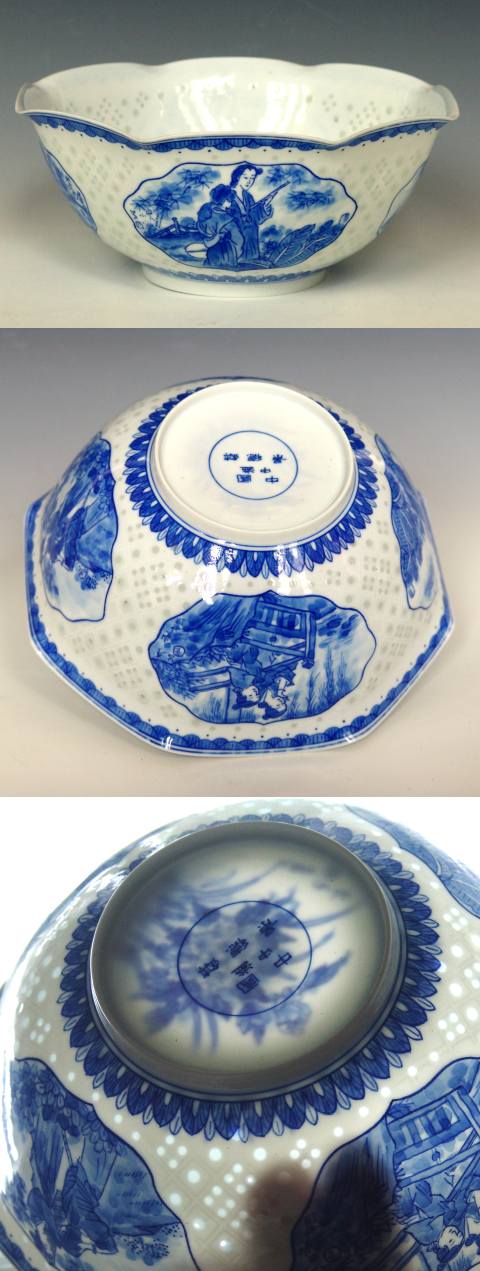
This bowl bought was bought by me in Jingdezhen 1991 directly in a street side shopping stall where I understood that porcelain workers privately could sell pieces they had made. Pieces of this quality was at this time not offered in any of the dusty state run shops that were all over central Jingdezhen. This bowl was the most complicated and rare design I had found so far, being made in a combination of underglaze blue both inside and outside, of eggshell thickness and in rice grain style.
The reason for its rarity seems to be easy enough to figure out. The porcelain body is first pierced for the 'rice grain' pattern to appear. On top of that, it is decorated entirely in underglaze blue decoration both inside and out, including the mark on the bse, on a porcelain body just slightly thicker than paper.
The bowl is fired fushao (upside down) resting on eight fire supports in the notches of the rim. From other pieces it appears as these near invisible firing support marks would have ultimately been hidden by a light blue on-glaze enamel border, which in this case has not been added.
The porcelain is extremely thin and in daylight the decoration on one side of the wall is easily seen from the other side, clear through the porcelain. The bowl must be handled with extreme care since it is very fragile.
The production of this kind of porcelain in Jingdezhen is now as far as I know discontinued as of the mid 1990s due to ending corporate state sponsorship, its high cost of production and extreme fragility.
Mark: Zhong Yi Factory, Jingdezhen, Zhong Guo (China). Size: Diameter at rim c. 7 inch/18 cm. Date of production 1992. Photo: JE Nilsson Coll. 2022
"Rice grain" is a name of a decorative technique rather than actual rice grains or anything like inserted in the walls. To make this kind of decoration the holes are pierced through the rather thick walls of the rough and unfired porcelain objects and the holes then filled with translucent glaze. When the entire unfired porcelain piece have dried enough to be handled, the walls are thinned down manually until the walls are as thin as the potter dares to make them.
The highly skilled potters, who are usually young women, after what I saw when I visited a factory for this kind of porcelain in Jingdezhen in the 1990s - are judging the thickness of the walls and the work progress by the sound of the paring knife against the unfired clay.
Originally this technique seems to have come to China from Turkey during the 14th century. The "rice grain" technique seems never to entirely have been abandoned even if it at times was rare. Sometimes the openings was left unfilled, which resulted in a wicker work appearance. This open work was called ling long yan (eye-like openwork) or 'devil's work'.
The Chinese scholars have it that this work was pioneered at the Hongzhou kilns around Luohu, Fengcheng, Jiangxi province, durong the Sui and Tang dynasties. In the Yongle reign of the Ming, extremely fine porcelains with the 'ling long' decorations was made in the Imperial kilns. After the Qianlong reign of the Qing dynasty both the Imperial and the folk kilns manufactured such wares.
Openwork porcelain also exists half and fully pierced in export porcelain from the later part of the Ming dynasty.
Today "rice grain" porcelain is common, since it is much appreciated and can be bought over the counter in most Asian food and porcelain stores all over the world. The last years products do not differ much from earlier product beside that they might be made with slightly more machines and that part of their decoration might be stamped, but all in all there are not much there to help you see a difference in the pieces from anywhere during the entire 20th century.
A